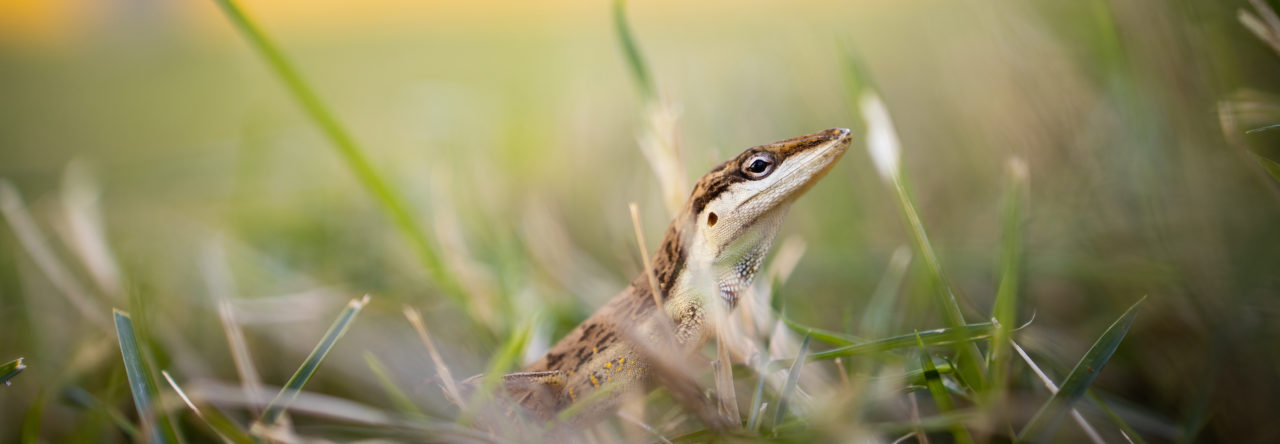
Shea Lambert and colleagues have just published a fabulous paper in Molecular Ecology on dewlap color evolution and reproductive character displacement in species in the Anolis brevirostris species complex. Manuel Leal and I wrote a perspective piece accompanying the paper that goes something like this:
‘Sibling species’, an old term that has fallen out of use, refers to closely related species that are so similar that it is hard to tell them apart. The existence of such species raises the obvious question: How do the animals themselves tell one another apart? And indeed, this is an active area of research (Tibbetts & Dale 2007; Uy et al. 2009). Usually, the species differ in one or more traits (i.e. species recognition signals) detectable with the sensory modalities upon which they rely (e.g. raptors use visual signals, frogs use sound and electric fish use different patterns of electric discharge).
A more general question concerns how such differences evolve. Over the last decade, it has become increasingly evident that mating signals can evolve under simultaneous selection for two functions (Fleishman et al. 2009): (i) eliciting attention (i.e. detectability); and (ii) species identification (i.e. distinguishing conspecifics from non-conspecifics). Historically, species recognition has attracted a significant amount of research from evolutionary biologists based on the assumption that if hybrids suffer reduced fitness or cannot be produced at all, then natural selection should favour individuals bearing traits that prevent such matings. This idea—confusingly termed either reinforcement or reproductive character displacement—had a rocky time in the evolutionary literature for many years, though now it is widely accepted (Servedio & Noor 2003; Rundle and Nosil, 2005; Pfennig & Pfennig 2009).
Near the dawn of the era of molecular ecology, one of the first studies to employ molecular tools to study the evolution of species recognition signals was Webster & Burns’ (1973) study of the evolution of dewlap colour in Anolis lizards. Anoles possess a retractable flap of skin under the throat, termed as dewlap, that is used in courtship, aggressive interactions and even encounters with predators (reviewed in Losos 2009). Anoles can be found in communities of as many as 15 species, and sympatric species never have identical dewlaps, leading to the hypothesis that the dewlap is used in species identification (Rand & Williams 1970).
Webster and Burns studied a highly unusual pattern of dewlap distribution in the Hispaniolan bark anole, Anolis brevirostris, along a transect on the western coast of Haiti (Fig. 1, above). Starting in the south, the lizards have a white dewlap. Then, abruptly the dewlaps become intensely orange; moving northwards, the intensity and size of the orange spot diminishes until it has almost disappeared, whereupon again there is an abrupt transition back to intense orange coloration that characterizes the northernmost populations.
Using the tools of the day, Webster and Burns employed starch-gel electrophoresis to examine six geographically varying protein loci. Analysis of these data yielded three important discoveries. First, the populations sorted into three groups: the white-dewlapped forms in the south, the orange-dewlapped forms in the north and a third, intervening form that exhibited clinal variation in the proportion of white vs. orange in the dewlap. Second, at the point of contact between the groups in both the north and the south, adjacent populations did not share alleles at several loci. Third, within the middle, clinally varying group, populationsshowed little genetic differentiation despite the differences in dewlap colour among populations.
Webster and Burns concluded that they were dealing not with a single species, but three—subsequently, the middle populations were described as A. caudalis and the northern ones as A. websteri. More importantly, what had seemingly been an incoherent pattern of geographic variation in dewlap colour variation now had a clear explanation. The apposition of orange vs. white at both ends of A. caudalis’s range is most parsimoniously explained as the result of selection for differences in species recognition signals in sympatry. The fact that A. caudalis maintains the clinal variation in the face of possibly strong ongoing gene flow, as evidenced by the lack of genetic differentiation among populations, was interpreted as powerful evidence for ongoing natural selection favouring dewlap colour differences at the contact zones with the other species.
Given this provocative pattern and the great interest in evolutionary reinforcement, it is surprising that this example has not been subject to further investigation as molecular tools have developed over the past four decades. Undoubtedly, the transect’s occurrence in Haiti, a notoriously difficult place for fieldwork, has been a factor. Finally, however, this case study has come under further scrutiny.
On a trip in Haiti that was no doubt a story in itself, Lambert et al. revisited Webster and Burns’ transect and report in this issue of Molecular Ecology the results of their phylogenetic and phenotypic analyses. Examining variation at mitochondrial and nuclear loci, Lambert et al. have demonstrated that Webster and Burns pretty much got it exactly right. Chalk one up for old school electrophoresis! Not only do the three species each fall out as monophyletic, but, as with the allozymes, A. caudalis exhibits little interpopulation genetic differentiation, in contrast to the deep genetic structure apparent among populations in the other two species. Moreover, phenotypic examination of dewlap coloration reaffirmed the patterns of clinal variation within A. caudalis and the abrupt shifts in coloration between sympatric species at either end of its range (Fig. 2).

Lambert et al.’s study not only completely corroborates Webster and Burns’ conclusions, but adds several important new perspectives on this case study.
Read More






























